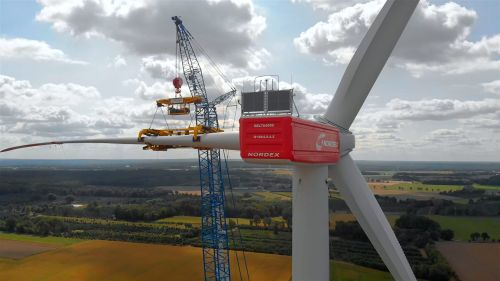
The trend toward ever-more-colossal turbines is not only cutting the cost of wind energy but could also deliver another important benefit: fewer bird deaths.
Although there are numerous complex factors behind wind-farm-related bird mortality, one key feature of current collision models is the swept-area ratio: the proportion of an at-risk area that is occupied by wind turbine blades. With larger turbines, the ratio goes down, thereby reducing bird deaths.
“Not all turbines are equal,” explained Tim Norman, U.K. director and vice president for offshore at Niras, an international engineering consultancy, in an interview. “The bigger you get, the more efficient they are. So they need less swept area for the same energy generation.”
The reduced ecological impact of larger, more powerful turbines has been known for some time.
In 2009, for example, a study of California’s Altamont Pass Wind Resource Area, a notorious spot for bird deaths, found that repowering old turbines with newer models that were three times more powerful could cut fatality rates by up to 65 percent.
The trend could end up being particularly important for offshore wind. Not only is that increasingly where future wind capacity is planned, but it’s also where the world’s largest turbines, such as the Siemens Gamesa 14-222 DD and the GE Haliade-X, are being installed.
A move from older turbines in the 5-megawatt range to these larger models of up to 15 MW apiece could make up to a 50 percent difference in the collision rate, said Norman. The effect is even more marked with taller turbines, because “birds have a very strong affinity to the sea surface. As you go up, you get fewer and fewer birds.”
This means collisions can be avoided by increasing the "air gap," or the space between the sea surface and the lowest point in the circumference of the turbine blades. With an air gap of 45 meters (148 feet), “you may not have a measurable impact at all” on marine birds, Norman said.
That's not far off the scale of the largest turbines available today. With a total height of 260 meters and a rotor diameter of 220 meters, the 12-megawatt Haliade-X already has an air gap of around 40 meters.
It’s important to note that the environmental benefits of larger, taller turbines are less clear-cut onshore. On land, birds that are migrating or using thermals can rise high above ground level, so very tall turbines could in some cases result in more avian mortality rather than less.
Paint it black
The U.S. Fish and Wildlife Service estimates that turbines could already kill 140,000 to 500,000 birds a year in America. Even at the high end, that is a small number compared to the hundreds of millions of bird deaths from collisions with buildings and automobiles or the billions of birds killed by cats, but it still looms large in permitting decisions.
The need to keep bird mortality in check has led to a range of avoidance and minimization strategies, which have seen varying degrees of success. Although the industry has high-tech tools such as radar tracking systems that can warn operators to shut down turbines when birds approach, their use does not seem to be widespread.
One radar vendor, DeTect, said, “We’ve done over 100 surveys, [but] I think we’ve deployed no more than half a dozen active ongoing operational assessments where we’re doing the curtailment of turbines,” said general manager Edward Zakrajsek in an interview.
Curtailment is a measure of last resort, and most developers now prefer to minimize bird kills using models to predict mortality at the design stage, said Norman.
Even though there have been hundreds of studies into wind-energy-induced avian mortality, it is still unclear whether the industry has managed to significantly reduce bird deaths on a per-turbine or per-megawatt basis.
Roel May, senior research scientist at the Norwegian Institute for Nature Research, was the lead author of a July report that highlighted a possible low-cost solution to eagle deaths at onshore wind farms. The study found that bird fatalities at Smøla, a Norwegian wind farm with a reputation for white-tailed eagle collisions, were reduced by more than 70 percent on turbines on which one of the blades had been painted black.
It remains to be seen whether the technique will work with other wind farms. But along with bigger turbines and other measures, it’s a promising development in tackling a problem the wind industry cannot afford to ignore.
"bird" - Google News
October 01, 2020 at 08:21PM
https://ift.tt/3l6tqdY
The Wind Sector Trend Helping to Minimize Bird Deaths - Greentech Media News
"bird" - Google News
https://ift.tt/2s1zYEq
https://ift.tt/3dbExxU
Bagikan Berita Ini














0 Response to "The Wind Sector Trend Helping to Minimize Bird Deaths - Greentech Media News"
Post a Comment